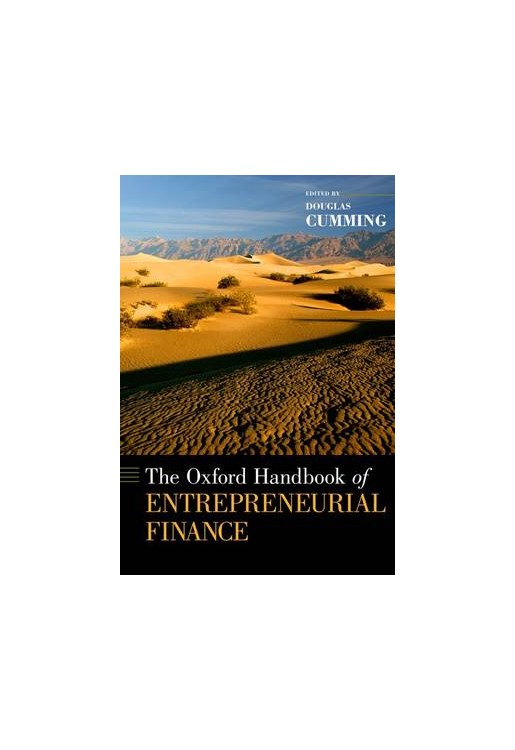The topic of Entrepreneurial Finance involves many issues, including but not limited to the risks and returns to being an entrepreneur, financial contracting, business planning, capital gaps and the availability of capital, market booms and busts, public policy and international differences in entrepreneurial finance stemming from differences in laws, institutions and culture. As these issues are so extremely broad and complex, the academic and practitioner
literature on topic usually focuses on at most one or two of these issues at one time. The Oxford Handbook of Entrepreneurial Finance provides a comprehensive picture of issues dealing with different sources of entrepreneurial finance and different issues with financing entrepreneurs. The Handbook
comprises contributions from 48 authors based in 12 different countries. The Handbook is organized into seven parts, the first of which introduces the issues, explains the organization of the handbook, and briefly summarizes the contributions made by the authors in each of the chapters. Part II covers the topics pertaining to financing new industries and the returns and risk to being an entrepreneur. Part III deals with entrepreneurial capital structure. Part IV discusses business planning,
funding and funding gaps in entrepreneurial finance with a focus on credit markets. Part V provides analyses of the main alternative sources of entrepreneurial finance. Part VI considers issues in public policy towards entrepreneurial finance. Part VII considers international differences in
entrepreneurial finance, including analyses of entrepreneurial finance in weak institutional environments as well as microfinance. This is a wide-ranging and comprehensive handbook which provides an outstanding introduction to the field. It provides an excellent overview of all the main aspects of financing entrepreneurial businesses and is to be welcomed especially for the broad range of international experience it covers. * Alan Hughes, Margaret Thatcher Professor of Enterprise Studies and Director of the Centre for Business Research, Judge Business School, University of Cambridge *
Part I. Introduction ; Chapter 1 ; <"Introduction to the Handbook of Entrepreneurial Finance>" ; Douglas Cumming, York University Schulich School of Business ; Part II. Financing New Industries and the Returns and Risk to Entrepreneurship ; Chapter 2 ; <"Finance of New Industries>" ; Brent Goldfarb, University of Maryland, David Kirsch, University of Maryland, and April Shen, University of Maryland ; Chapter 3 ; <"The Returns to Entrepreneurship>" ; Thomas Astebro, HEC-Paris ; Chapter 4 ; <"Risk Attitudes and Private Business Equity>" ; Frank Fossen, German Institute for Economic Research (DIW Berlin) ; Chapter 5 ; <"New Firm Financing and Performance>" ; Sheryl Winston Smith, Temple University ; Part III. Entrepreneurial Capital Structure ; Chapter 6 ; <"New Perspectives on Entrepreneurial Capital Structure>" ; David Robinson, Duke University Fuqua School of Business ; Chapter 7 ; <"The Capital Structure of Family Firms>" ; Markus Ampenberger, Technische Universitat Munchen, Morten Bennedsen, INSEAD, and Haoyong Zhou, Copenhagen Business School ; Chapter 8 ; <"Influence of Internal Factors on the Use of Equity- and Mezzanine-Based Financing in Family Firms>" ; Ann-Kristin Achleitner, Technische Universitat Munchen, Eva Lutz, Technische Universitat Munchen, and Stephanie Schraml, Technische Universitat Munchen ; Part IV. Funding: Planning, Credit Markets and Gaps ; Chapter 9 ; <"Planning for Entrepreneurial Finance and Capital: A Critical Review of the Importance of Teaching Business Planning>" ; Benson Honig, McMaster University ; Chapter 10 ; <"Funding Gaps>" ; Robert Cressy, University of Birmingham ; Chapter 11 ; <"Availability of Credit to Small Firms Young and Old: Evidence from the Surveys of Small Business Finances>" ; Rebel Cole, DePaul University ; Chapter 12 ; <"Asymmetric Information, Credit Market Condition and Entrepreneurial Finance>" ; Liang Han, University of Hull Business School, and Song Zhang, University of Hull Business School ; Part V. Alternative Types of Entrepreneurial Finance ; Chapter 13 ; <"Crowdfunding of Entrepreneurial Ventures>" ; Armin Schwienbacher, SKEMA Business School, Universite de Lille, and Benjamin Larralde, University of Luxembourg, Luxembourg Business Academy ; Chapter 14 ; <"Angel Investors and their Investments>" ; Ramon P. DeGennaro, University of Tennessee, Knoxville ; Chapter 15 ; <"Firm Growth, Schumpeterian Entrepreneurship and Venture Capital>" ; Michael Peneder, University of Vienna University of Economics and Business, Austrian Institute of Economic Research ; Chapter 16 ; <"Why Do Firms Go Public?>" ; James Brau, Brigham Young University ; Chapter 17 ; <"Valuation of IPOs>" ; Rajesh Aggarwal, University of Minnesota, Sanjai Bhagat, University of Colorado, Boulder, Srinivasan Rangan, University of Colorado, Boulder ; Chapter 18 ; <"What is Trade Credit and Why Does it Exist?>" ; Vicente Cunat, London School of Economics and Universitat Pompeu Fabra, and Emilia Garcia, Universitat Pompeu Fabra ; Chapter 19 ; <"Factoring and Invoice Financing>" ; Khaled Soufani, John Molson School of Business, Concordia University ; Chapter 20 ; <"Project Finance>" ; Stefano Gatti, Bocconi University, Stefano Caselli, Bocconi University, and Alessandro Steffanoni, Interbanca S.P.A. - ABN AMRO Group ; Chapter 21 ; <"Hedge Fund Asset-Based Lending>" ; Houman Shadab, New York Law School ; Part VI. Public Policy ; Chapter 22 ; <"Business Taxation, Corporate Finance and Economic Performance>" ; Christian Keuschnigg, University of St. Gallen, and Evelyn Ribi, University of St. Gallen ; Chapter 23 ; <"Financing Capital among Minority-Owned Businesses>" ; Robert Farlie, University of California Santa Cruz, and Alicia Robb, University of California Santa Cruz ; Chapter 24 ; <"Financing Women Owned Businesses: A Review of Recent Literature>" ; Susan Coleman, University of Hartford, and Alicia Robb, University of California Santa Cruz ; Part VII. International Comparisons and Microfinance ; Chapter 25 ; <"International Differences in Entrepreneurial Finance>" ; Larry Chavis, University of North Carolina Kenan-Flagler Business School, Leorra Klapper, World Bank, and Inessa Love, World Bank ; Chapter 26 ; <"Entrepreneurial Finance in Weak Institutional Environments>" ; David Lingelbach, University of Baltimore and Johns Hopkins University ; Chapter 27 ; <"Microfinance for Entrepreneurs>" ; Miriam Bruhn, World Bank, Fenella Carpena, World Bank, and Bilal Zia, World Bank ; Chapter 28 ; <"The Past and Future of Innovations in Microfinance>" ; Roy Mersland, University of Agder, Kristiansand, Norway, and R. Oystein Strom, Oslo University Colle, Oslo, Norway


